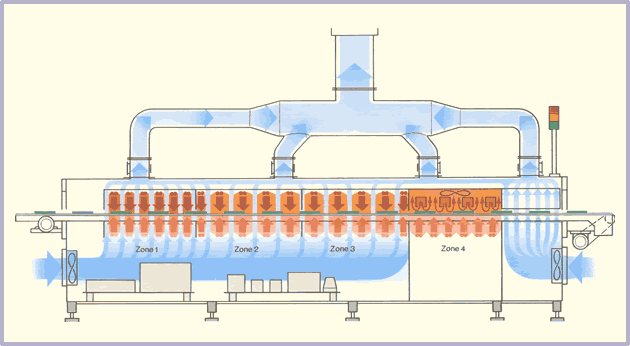PCB Prototype Manufacturer
What Purpose does Solder Mask Serve?

As the name suggests, this is a chemical layer on an unpopulated printed circuit board (PCB) with openings for the areas solder will cover and for masking the rest. The main objective is to prevent solder from accidentally bridging neighboring pads or tracks during assembly, and to protect the board from the environment. Although both are protective coatings, solder mask is not a conformal coating, as the latter protects an assembled board.
Solder mask plays an important role during PCB assembly. Designers place solder mask dams between surface mount pads, and this prevents accidental solder bridging during assembly, greatly reducing the amount of rework for removing shorts. However, not all SMD pads can have solder mask dams between them, especially the fine-pitch components. The spacing between the pads for such components is so small that no solder mask dam is possible.
Solder mask has other uses as well, such as preventing solder starvation. Usually, solder should bind the component lead to its copper pad. However, if solder mask does not cover the track attached to the copper pad, molten solder can flow down the track, starving the pad of adequate solder, thereby creating an unreliable joint. The presence of an uncovered via near a pad also serves to wick molten solder into its hole, again starving the pad of adequate solder. Covering the via with solder mask prevents this wicking.
Types of Solder Mask
The most common color for the solder mask material is green, but fabricators may also use material of other colors such as black, white, yellow, blue, red, and green, depending on their customers’ preference. Earlier processes for solder mask application were through pattern printing. However, with PCB technology increasingly progressing towards fine-pitch components, the screen-printing technique of solder mask application does not offer adequate definition.
Considerations while designing a PCB
The IPC-SM-840C standard offers information on the use of solder mask. The standard facilitates the evaluation, qualification, and performance of permanent solder mask materials.
A designer must be careful to oversize the solder mask artwork to allow for improper registration or slump, as this can obscure or contaminate a pad surface, causing defective joints or excessive solder accumulation. Best practices dictate the solder mask aperture should be 75 um larger than the pad on either side, or 150 um larger than the pad diameter, to discourage solder mask encroachment. Moreover, the fabrication drawing should carry a note stating solder mask should not encroach on component pins or pads, while board fabricator may modify the solder mask aperture where necessary.
The note should also indicate vias the project wants to use as test points, as these would have to remain clear of solder mask on the side of probing, and therefore, have an opening in the solder mask for the purpose. The opening should preferably be 100 um larger than the finished drill size of the via. This will allow gases entrapped in the via to escape during wave soldering while solder fills the via and makes it a good test probe target. Designers may allow tenting on vias not meant for test probing, which means these vias will remain covered by solder mask.
Although solder mask between pads acts as a dam to prevent solder bridging, some fine-pitch components may have pins very closely spaced, leaving no possibility of introducing solder mask in between. In such cases, designers resort to mask defined pads. As the name suggests, they allow the solder mask to define the pad size. For this, they make the mask relief the same size or smaller than the underlying copper pad. For such cases, the designer must include a fab note stating the fabricator must not adjust the marked pads.
Conclusion
The solder mask is an important part of the PCB manufacturing process, helping not only to protect the board from the environment, but also preventing excess solder from creating shorts. Nowadays, fabricators prefer to use the liquid photo imageable solder mask, as it offers several advantages of easy usage, higher durability, and reliability.
Top 10 High Quality Power Stencils in India, PCB Manufacturing Services, Turnkey PCB Manufacturer in India, PCB Prototype Manufacturer, PCB Fabrication and Assembly, PCB Cost Calculator, Buy Electronic Components Online, High Frequency Power Stencils in India, PCB Fabrication Services in India, Printed Circuit Board in India, Fabrication PCB, PCB Board, PCB Production, PCB Order, PCB Prototype, PCB Manufacturer, PCB Prototype Manufacturer, PCB Prototype Assembly, PCB Low Cost, PCB Prototype Fabrication, PCB Manufacturing, PCB Prototype Low Cost, Prototype PCB Board Manufacturer, PCB Manufacturing Service, Prototype Circuit Board Manufacturers, Cest PCB Prototype Service, PCB Manufacturing in India, PCB Fabrication Process, PCB Board Material, How to use Printed Circuit Board, How to use PCB Fabrication, PCB Online calculator, PCB Electronic Circuit Board, PCB Assembly Process, PCB Online Store, PCB Component Sourcing Material, PCB Power, PCB Power Login, PCB Manufacturing, PCB Fabrication, PCB Online, Online PCB design, PCB Power supply, PCB electronics, PCB design India, PCB Board price in India, PCB Service, PCB Maker, PCB Stencil, Power Circuit Board, PCB Printing Service, Custom PCB, PCB India, PCB Manufacturing Cost, PCB Order, PCB Online Quote, Buy PCB